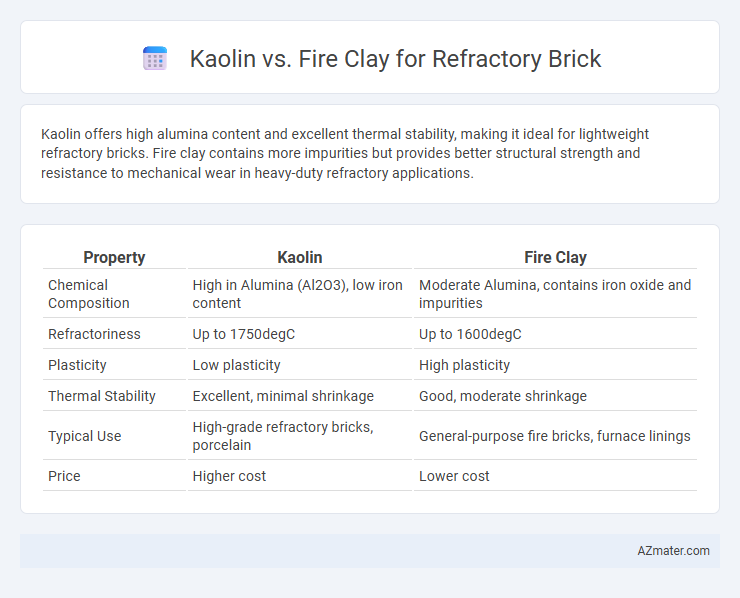Kaolin offers high alumina content and excellent thermal stability, making it ideal for lightweight refractory bricks. Fire clay contains more impurities but provides better structural strength and resistance to mechanical wear in heavy-duty refractory applications.
Table of Comparison
| Property | Kaolin | Fire Clay |
|---|---|---|
| Chemical Composition | High in Alumina (Al2O3), low iron content | Moderate Alumina, contains iron oxide and impurities |
| Refractoriness | Up to 1750degC | Up to 1600degC |
| Plasticity | Low plasticity | High plasticity |
| Thermal Stability | Excellent, minimal shrinkage | Good, moderate shrinkage |
| Typical Use | High-grade refractory bricks, porcelain | General-purpose fire bricks, furnace linings |
| Price | Higher cost | Lower cost |
Introduction to Refractory Bricks
Refractory bricks, essential for high-temperature industrial applications, rely heavily on materials like kaolin and fire clay for their thermal stability and durability. Kaolin, characterized by its high alumina content and fine particle size, offers excellent resistance to thermal shock and chemical corrosion. Fire clay, with its balanced silica and alumina composition, provides superior plasticity and strength, making it ideal for forming robust, heat-resistant bricks in furnaces and kilns.
What is Kaolin? Properties and Uses
Kaolin is a white, soft clay primarily composed of the mineral kaolinite, known for its high alumina content and excellent thermal stability, making it a vital raw material in refractory brick manufacturing. Its properties include low thermal expansion, good plasticity, and resistance to chemical corrosion, which enhance the durability and heat resistance of refractory bricks. Kaolin is extensively used in ceramics, paper coating, and as a key component in producing fire clay refractories, providing structural strength and thermal insulation.
What is Fire Clay? Properties and Uses
Fire clay is a highly refractory, heat-resistant material composed mainly of kaolinite, used in producing refractory bricks capable of withstanding temperatures above 1,500degC. Its properties include high alumina content, excellent plasticity, and resistance to thermal shock and chemical attack, making it ideal for furnaces, kilns, and other high-temperature applications. Fire clay bricks provide durability and thermal insulation for industries such as steelmaking, glass manufacturing, and ceramics production.
Chemical Composition: Kaolin vs Fire Clay
Kaolin primarily consists of the mineral kaolinite with a chemical composition rich in silica (SiO2) and alumina (Al2O3), typically containing around 45-55% silica and 35-40% alumina, making it highly refractory and stable at high temperatures. Fire clay, in contrast, contains a more varied composition with higher amounts of alumina, usually between 25-40%, silica levels ranging from 30-50%, and additional iron oxide (Fe2O3) content up to 5%, which can influence thermal properties. The higher alumina content in fire clay enhances its heat resistance and mechanical strength, while kaolin's purer silica and alumina balance provides better plasticity and workability for refractory brick manufacturing.
Thermal Stability and Heat Resistance
Kaolin exhibits excellent thermal stability with a melting point around 1700degC, making it suitable for refractory bricks subjected to moderate heat but less resistant to rapid temperature changes. Fire clay, containing higher alumina content (35-45%), offers superior heat resistance and can withstand temperatures up to 1750degC or more, ensuring enhanced durability under extreme and fluctuating thermal conditions. The choice between kaolin and fire clay hinges on the specific thermal demands of the application, with fire clay preferred for higher, more variable heat environments.
Workability in Brick Making
Kaolin offers superior workability in refractory brick making due to its fine particle size and plasticity, allowing for easier molding and shaping. Fire clay, with its coarser texture and lower plasticity, requires more water and mechanical effort to achieve the desired form, impacting production efficiency. Optimizing clay blends often balances kaolin's ease of workability with fire clay's high-temperature resistance for durable refractory bricks.
Cost Comparison and Availability
Kaolin refractory bricks typically cost more than fire clay bricks due to higher purity and enhanced thermal resistance, impacting overall project expenses. Fire clay bricks are more widely available and generally less expensive, benefiting from abundant natural deposits and simpler manufacturing processes. Choosing between kaolin and fire clay bricks depends on budget constraints and the required performance level in high-temperature applications.
Performance in High-Temperature Applications
Kaolin-based refractory bricks exhibit superior thermal stability and resistance to chemical corrosion at temperatures exceeding 1400degC, making them ideal for high-temperature furnaces and kilns. Fire clay bricks offer excellent thermal shock resistance and mechanical strength up to around 1300degC, but they tend to degrade faster under extreme temperature fluctuations compared to kaolin bricks. The high alumina content in kaolin enhances its refractoriness and structural integrity, ensuring longer service life in aggressive high-temperature environments.
Pros and Cons: Kaolin vs Fire Clay for Refractory Bricks
Kaolin offers high purity and excellent thermal stability, making it ideal for lightweight refractory bricks with superior insulation properties; however, it is less resistant to mechanical stress compared to fire clay. Fire clay provides greater strength and durability at high temperatures, making it suitable for heavy-duty refractory bricks, but it contains more impurities, which can affect thermal efficiency. Choosing between kaolin and fire clay depends on whether thermal insulation or mechanical durability is the priority for the refractory application.
Which is Better for Refractory Bricks?
Kaolin and fire clay are both essential materials for refractory bricks, but fire clay generally offers superior thermal stability and higher fusion points, making it better suited for high-temperature industrial applications. Kaolin provides excellent plasticity and fine particle size, enhancing the brick's workability and surface finish, but it lacks the heat resistance of fire clay. For refractory bricks requiring durability under extreme thermal stress, fire clay is typically the preferred choice due to its enhanced alumina content and resistance to slag and chemical attack.

Infographic: Kaolin vs Fire Clay for Refractory Brick
 azmater.com
azmater.com